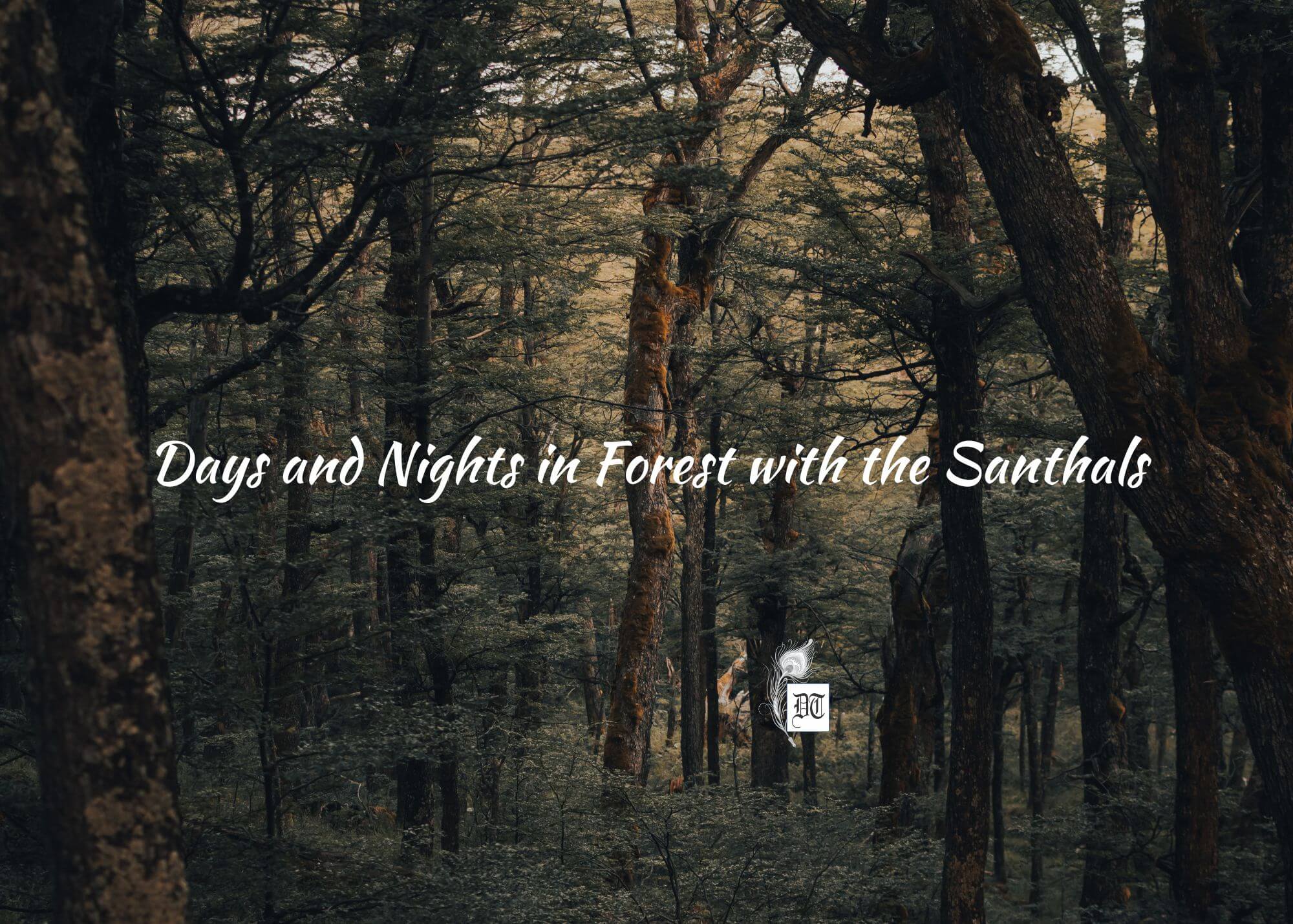Reading Time: 6 minutes
Soumya travels to a Santhal forest to peek into their lives, where reel and real intersect – exclusively for Different Truths.


Aranyer din ratri… days and nights in the forest
This was the title of Satyajit Ray’s iconic film about a visit to the Santhal Parganas.
We were planning a similar trip to a forest eco-resort in the area.
Hearing that the nearest railhead is Muri, I returned to another childhood memory, the Tenida classic Char Murti, where the adventure starts from Muri Station.
Watching the Kannada film, Kantara brought back the stories I heard from the Santhal people …
Watching the Kannada film, Kantara brought back the stories I heard from the Santhal people we met there.
We were the only passengers to alight at the sleepy station at Muri and found no one waiting for us.
Someone from the homestay was supposed to pick us up
This reminded me of Tanida’s adventures, for they, too, found no one at the station and had to walk.
As the forest area didn’t have internet coverage, we couldn’t use Google maps. Hence driving there was ruled out.
But the deserted station compound had a single vehicle parked there, and a man was sleeping inside.
On being woken up, he told us that he was our guide, more like Char Murtir Avijan, where their guide had been taking a nap and missed the train.
Anyway, he took us down narrow, winding, thickly forested tracks for an hour’s drive to our destination, a scenic set of five cottages next to a lake surrounded by hills and forests.
We walked, trekked, explored the waterfalls and villages…
We walked, trekked, explored the waterfalls and villages, and tried swimming in the lake and climbing the rocks.
Our driver for the next few days and all the employees at the resort were Santhals from a nearby village, which we also explored as their guests.
We were the only guests, and some government officials on a survey, staying in tents nearby, came for meals, as it was the only place serving meals in the area if informed in advance.
Meals were rice; veggies were grown there, fish from the lake or the stream next to it, free-range chicken kept there, only the sweets being brought from the town and stored there.
They could also arrange for Mahua, the forest liquor popular with the tribals, and had musical instruments, which were a part of their lives, and promised us a full-blast party once the other people left.
As a child, I used to visit my grandparents’ farm in winter and made friends with his farmhand’s children, many of them Santhal and visited their villages. I had also picked up a smattering of Santhali.
Santhals, Muslims, Kevat or fishermen, all tenant farmers, had separate villages.
I remembered many of their customs and a bit of the language…
I remembered many of their customs and a bit of the language and pestered our hosts, trying to see what changes had occurred over four decades.
The government officials left the next day, and the evening became a riot of music, dancing, and Mahua, in which we participated fully. My daughter, a skilled musician, wowed them with her ability to pick up their instruments and tunes, if not the words, and were even indulgent of my amateurish attempts and invited us to their nightlong sessions in the villages, as it was Govardhan puja time, with five days of non-stop festivities, culminating in the pig sacrifice.
But I will write more about this later.
Here I want to discuss the changes I noted in their lifestyles. And some intriguing insights gained from their answers to my questions and stories shared by them.
I learned that the Santhal language now had a script and was taught in school.


A funny change I noticed was that instead of calling everyone by the familiar to as earlier, which offended government, judicial and police officials, they now referred to everyone by the honorific aap, including when referring to the pigs.
None of them had converted to Christianity, and there were no churches or missionaries, unlike their counterparts just across the border, and the reasons weren’t clear. They were nominally Hindus but worshipped the ancient spirit Gods or Bongas and had no temples, just thans, which could be a tree, grove, rock, cave, or spring. And totems in the villages.
The mainstream Hindu Gods were incorporated into their religion…
The mainstream Hindu Gods were incorporated into their religion, the names sometimes changed, and major Hindu festivals were celebrated in their unique way, which involved feasting rather than fasting, music, dance, liquor, and animal sacrifice. The Vaishnava festival of Govardhan puja, one of their major festivals, which we witnessed, was celebrated in the same way, and the cows were worshipped with much dancing and singing. It culminated on Diwali with a pig sacrifice.
Incidentally, the neighbourhood Christian tribes celebrated Xmas the same way, with chicken sacrifice and songs replacing their ancient spirit Gods with Jesus.
The Ojha or shaman still ruled, and only for major diseases was the doctor consulted, but parallel treatment by the shaman continued without the doctor’s knowledge.
Their main livelihood was cutting wood from the forests, selling it in the nearest towns, and carrying it all the way. This is the only work that the men did.
The women did everything else, farming, field work, animal husbandry, gathering forest produce, housework, and even building the huts. We witnessed this during the festival, and homes were repaired, painted, and decorated beautifully by the women, who even collected the materials from the forest.
The men also hunted, especially during the traditional hunting festival …
The men also hunted, especially during the traditional hunting festival or Hool, which is still strong despite being banned by the law.
They said that forest officials being government servants, rarely visited the forests and anyway didn’t want to antagonise the people. Many were from the villages and secretly participated.
The police wanted bribes, but only if you used the border posts they manned, which could be easily avoided.
The area was a Maoist stronghold, and the army was stationed there for ten years after the uprising was suppressed. The Naga battalion there became good friends of the villagers and helped them in many ways, including farming, giving medical care and provisions and giving people lifts. They learnt Santhali and many villagers spoke Nagamese.
They’ve been replaced by the CRPF, which is more aloof and threatening.
Western clothes have replaced the earlier brief clothing for men and younger women, and the older women wore saris but far more modesty.
The population was 90 % of Santhal, but the men in power were Mahatos.
The population was 90 % of Santhal, but the men in power were Mahatos. As our driver explained, the tribals were simple people and dealing with cunning outsiders could only be done by the cleverer Mahatos.
The government had tried to settle Muslim immigrants from the neighbouring countries there, but the belligerent natives soon drove them out, and there were no Muslims outside the towns.
They still carried the ubiquitous axe, an essential part of their wardrobe, but nowadays left them and other arms like bows and arrows and spears at home when visiting the town, courts, or government offices, as it scared the babus.
They also confessed that the animals have become scarce because of constant hunting, but it was their vocation and couldn’t be stopped. This conflict is shown in the film Kantara, based in Karnataka. I suppose the stories of indigenous forest dwellers are the same everywhere.
The musicians and dancers visited different parts of India as part of the cultural troupe…
The musicians and dancers visited different parts of India as part of the cultural troupe and interacted with folk artists from other cultures. The younger generation was literate, and the village headman proudly told us that his granddaughter was the first postgraduate from the area and worked as a nurse in the town.
The Maoists had disappeared, but they had introduced the idea of their rights and political power to the people, and they were keenly conscious and proud of their identity. They were aware and incredibly proud that the latest president of India is from their community, the first tribal to hold the top post in our country. Still, they said they’re keenly watching whether she remains one of them or becomes an alien, like all the city people.


Picture design by Anumita Roy
















